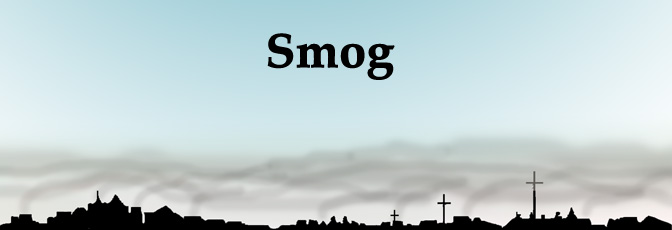

Though ozone in the atmosphere protects the earth from the sun’s powerful ultraviolet, when it forms on the ground it can be harmful to people, animals and plants. This is called smog.
Ozone forms on the ground when the exhaust from cars, factories and chemicals mix with hot temperatures and strong sunlight. All these things together make smog. Smog is becoming common in cities like Los Angeles and can cause serious health issues. Some cities have ozone alerts where they ask people to stay indoors when smog levels are high.
To help understand smog, let’s create some in a jar.
Materials:
1. One jar
2. An aluminum foil top
3. Some ice cubes
4. Some paper and matches
5. Help from an adult
Procedures:
To make smog, everything has to be done fast – so have everything on hand and ready.
1. First, rinse the jar out – so the sides are coated with water.
2. Make a lid with the foil.
3. Set it aside with the ice cubes on top to cool.
4. Have your adult helper light the paper on fire and drop it in the jar.
5. Quickly put on the cold foil lid and put the ice cubes back on top.
6. Look into the jar.
4. Do you notice how the smoke sits on the bottom of the jar? This is the way smog forms.
5. Don’t breathe it in when you release your smog outside. It’s bad for you!
Explanation: You just created the conditions for smog. You added air pollution (smoke) to a closed environment (the jar – the city). Adding the ice cubes on top mimicked the heat of the city trapped under a cooler atmosphere. This didn’t allow the smoke to rise into the atmosphere and break up. Instead it sat on the ground – as smog.
NGSS: Appendix F – Science and Engineering Practices
Practice 3 - Planning and Carrying Out Investigations
K–2 Condensed Practices
Planning and carrying out investigations to answer questions or test solutions to problems in K–2 builds on prior experiences and progresses to simple investigations, based on fair tests, which provide data to support explanations or design solutions.
3-5 Condensed Practices
Planning and carrying out investigations to answer questions or test solutions to problems in 3–5 builds on K–2 experiences and progresses to include investigations that control variables and provide evidence to support explanations or design solutions.
6–8 Condensed Practices
Planning and carrying out investigations in 6-8 builds on K-5 experiences and progresses to include investigations that use multiple variables and provide evidence to support explanations or solutions.
When you research information you must cite the reference. Citing for websites is different from citing from books, magazines and periodicals. The style of citing shown here is from the MLA Style Citations (Modern Language Association).
When citing a WEBSITE the general format is as follows.
Author Last Name, First Name(s). "Title: Subtitle of Part of Web Page, if appropriate." Title: Subtitle: Section of Page if appropriate. Sponsoring/Publishing Agency, If Given. Additional significant descriptive information. Date of Electronic Publication or other Date, such as Last Updated. Day Month Year of access < URL >.
Amsel, Sheri. "Smog Alert! Activity - What Conditions Cause Smog to Form?" Exploring Nature Educational Resource ©2005-2025. April 7, 2025
< http://www.exploringnature.org/db/view/Smog-Alert-Activity-What-Conditions-Cause-Smog-to-Form >


